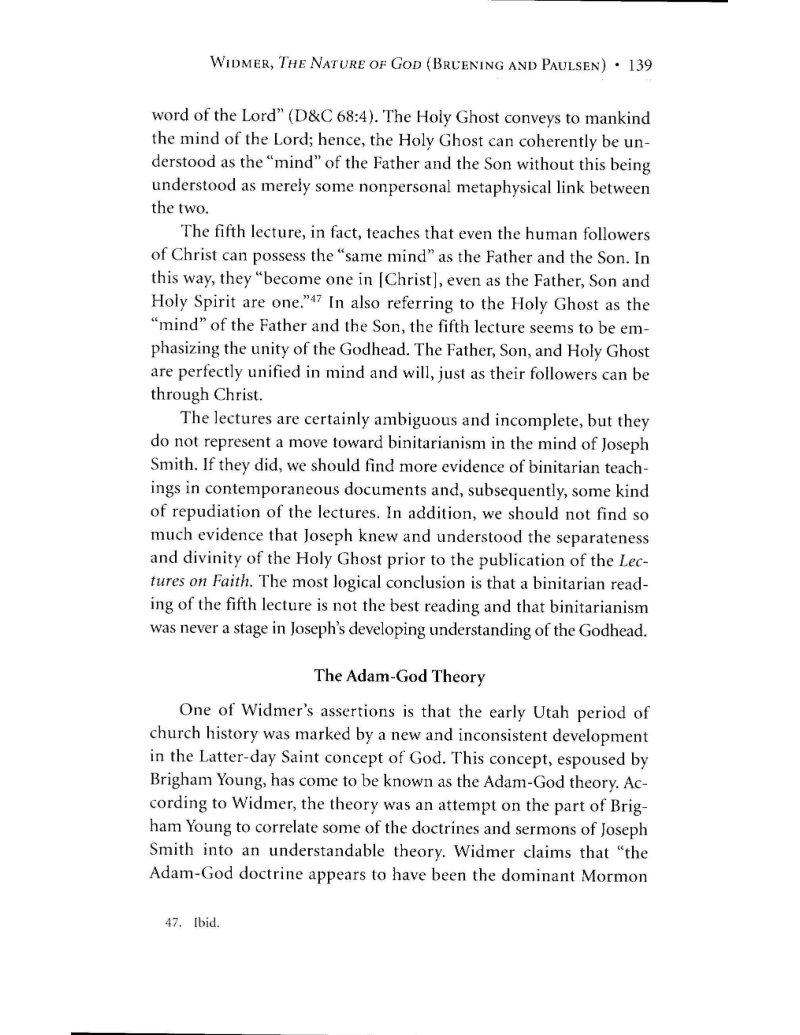Ari D. Bruening and David L. Paulsen offers objections to Adam-God being an accepted doctrine of the Church in the 19th-cenutry.
- Type
- Academic / Technical Report
- Source
- Ari D. Bruening LDS
- Hearsay
- DirectSecondary
- Reference
Ari D. Bruening and David L. Paulsen, "The Development of the Mormon Understanding of God: Early Mormon Modalism and Other Myths," FARMS Review 13, no. 2 (2001): 139-41
- Scribe/Publisher
- Foundation for Ancient Research and Mormon Studies
- People
- Ari D. Bruening, David L. Paulsen
- Audience
- Reading Public
- Transcription
The Adam-God Theory
One of Widmer's assertions is that the early Utah period of church history was marked by a new and inconsistent development in the Latter-day Saint concept of God. This concept, espoused by Brigham Young, has come to be known as the Adam-God theory. According to Widmer, the theory was an attempt on the part of Brig- ham Young to correlate some of the doctrines and sermons of Joseph Smith into an understandable theory. Widmer claims that "the Adam-God doctrine appears to have been the dominant Mormon theological position on the godhead during the latter half of the 19th century" (p. 131). The Adam-God theory may have been taught by Brigham Young, but it was never the dominant position of the church.
At least four reasons lead us to believe that the Adam-God theory was not the dominant Mormon position Widmer claimed it to be.
First, the theory itself was so little known within the LOS community that for the first half of the twentieth century, many questioned whether Brigham Young had even held the idea himself.
Second, other than Brigham Young's discourses; a few sermons by Brigham Young's close associate and brother-in-law, Heber C. Kimball; and a few items published by Frederick G. Williams in the English Mission, far from the center of the Saints, the church was silent on the subject. The prominent exception to this, of course, was Elder Orson Pratt, who was quite vociferous in his opposition to the theory. In his polemical and strongly anti-Brigham Young book, The Rocky Mountain Saints, apostate T. B. H. Stenhouse wrote that "The mass of the Mormon people do not believe in the Adam-deity, but of them all, one only, Orson Pratt, has dared to make public pro-test against that doctrine."
Third, even Brigham Young seems to have granted that his theory was not widely accepted and was, at the least, difficult to understand. In President Young's later comments on his theory, he admitted that the subject should "not concern us at present." Indeed, speaking five years after that statement, President Young admitted that in considering God's history, when we arrive at that point, a vail is dropt, and our knowledge is cut off. Were it not so, you could trace back your history to the Father of our spirits in the eternal world ....
Whether Adam is the personage that we should consider our heavenly Father, or not, is considerable of a mystery to a good many. I do not care for one moment how that is; it is no matter whether we are to consider Him our God, or whether His Father, or His Grandfather.
Finally, shortly after Brigham Young's death the church officially stated in three First Presidency messages that Adam is not to be con- fused with God the Father or any other member of the Godhead. A private letter coauthored by President Wilford Woodruff-fourth president of the church and a contemporary of Brigham Young-and Apostle Joseph F. Smith makes clear that the Adam-God theory was never widely held nor accepted by the church as an official doctrine:
President Young no doubt expressed his personal opinion or views upon the subject. What he said was not given as revelation or commandment from the Lord. The doctrine was never submitted to the councils of the Priesthood nor to the Church for approval or ratification, and was never formally or otherwise accepted by the Church. It is therefore in no sense binding upon the Church.
Widmer's claim that the Adam-God theory was the accepted LDS doctrine during the latter half of the nineteenth century is without basis. The theory was never official doctrine; neither was it widely accepted by the Saints. It was refuted by the leaders of the church not long after Brigham Young's death, and it is not accepted today.
- Citations in Mormonr Qnas
The B. H. Roberts Foundation is not owned by, operated by, or affiliated with the Church of Jesus Christ of Latter-day Saints.

